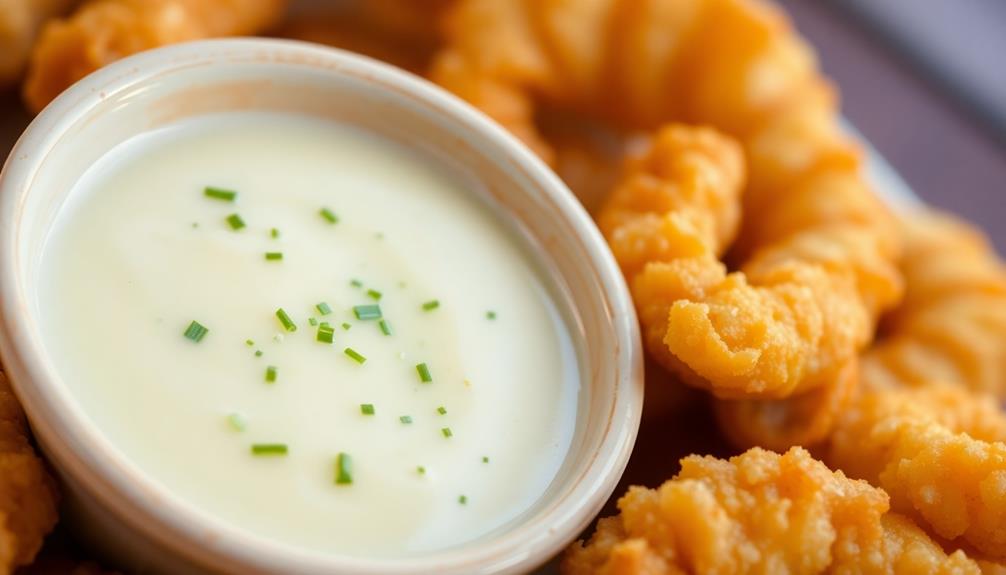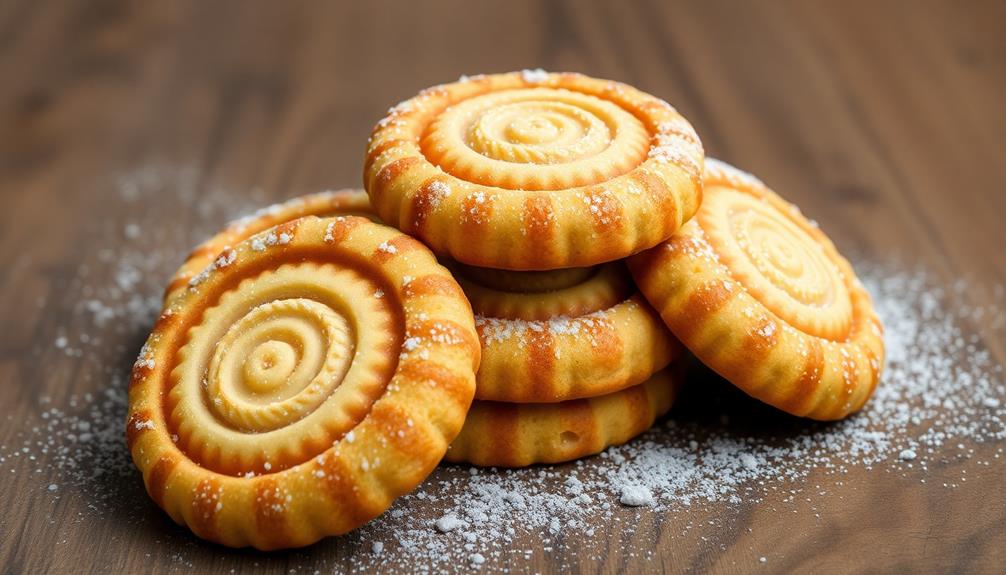Bring the rich history and flavors of eggnog into your home this holiday season. This classic beverage originated in 13th-century England, evolving into a cherished tradition often spiked with spirits. To make the perfect batch, you'll need fresh eggs, cream, sugar, and optional spices or alcohol. Whisk the ingredients, chill, and enjoy the smooth, creamy texture and festive flavors. Consider adding a splash of rum or brandy for an extra festive kick. Whether served warm or chilled, homemade eggnog is sure to delight and create new holiday memories. And there's more where that came from…
Key Takeaways
- A classic holiday drink with a rich, creamy texture and festive flavors, made with fresh eggs, cream, sugar, and optional spices or alcohol.
- Originated in 13th-century England and evolved into a cherished tradition, often spiked with rum, brandy, or whiskey, and garnished with nutmeg or cinnamon.
- Detailed instructions include whisking eggs and sugar, adding milk and vanilla, chilling the mixture, and optionally adding rum or brandy for enhanced flavor.
- Precise measurements, fresh ingredients, and proper mixing techniques are crucial for achieving the desired smooth texture and balanced taste.
- Serving suggestions include enjoying the eggnog chilled or warm, and pairing it with holiday treats and meals, while creating new traditions with loved ones.
History

Eggnog has a long and storied history, tracing its origins back to 13th-century England. What began as a warm, milky beverage enjoyed by the aristocracy slowly evolved over the centuries, making its way across the Atlantic to the American colonies.
By the 18th century, eggnog had become a beloved holiday tradition, often spiked with rum, brandy, or whiskey. As the recipe spread, it took on regional variations, with some versions calling for the addition of spices like nutmeg or cinnamon.
Today, eggnog remains a cherished part of the holiday season, a creamy, indulgent treat that evokes feelings of nostalgia and celebration.
Whether enjoyed on its own or used as a base for festive cocktails, this rich, frothy drink continues to be a staple in homes and gatherings around the world.
Recipe

Eggnog is a classic holiday drink that has been enjoyed for centuries. Its rich, creamy texture and warm, festive flavors make it the perfect accompaniment to any holiday gathering. Whether you're serving it at a party or sipping it by the fire, this homemade eggnog recipe is sure to delight your taste buds.
The key to a truly delicious eggnog is using fresh, high-quality ingredients. The combination of eggs, cream, and sugar creates a smooth and indulgent beverage that can be enjoyed on its own or used as a base for cocktails.
Ingredients:
- 6 large egg yolks
- 1/2 cup granulated sugar
- 2 cups whole milk
- 1 cup heavy cream
- 1 teaspoon vanilla extract
- 1/2 teaspoon ground nutmeg
Instructions:
In a large bowl, whisk the egg yolks and sugar together until the mixture is pale and thick.
In a saucepan, heat the milk and cream over medium heat, stirring occasionally, until it begins to steam and small bubbles form around the edges.
Slowly pour the hot milk mixture into the egg yolk mixture, whisking constantly.
Pour the mixture back into the saucepan and cook over medium heat, stirring constantly, until the mixture thickens enough to coat the back of a spoon, about 5-7 minutes.
Remove from heat and stir in the vanilla extract and nutmeg.
When making this eggnog recipe, it's important to be cautious when cooking the eggs to avoid scrambling them.
Additionally, the eggnog can be stored in the refrigerator for up to 5 days, making it a great make-ahead option for holiday gatherings.
Feel free to experiment with the spices, such as adding a pinch of cinnamon or a splash of rum or brandy, to create your own unique twist on this classic holiday beverage.
Cooking Steps

First, combine the eggs, sugar, and milk in a large bowl, then stir in the vanilla extract.
Next, whisk the egg mixture continuously until it thickens slightly.
Step 1. Combine Eggs, Sugar, and Milk

Next, you'll want to combine the eggs, sugar, and milk. In a large bowl, crack the 6 eggs and whisk them together until they're well blended. Next, gradually add the sugar to the eggs, whisking continuously to ensure a smooth mixture. Slowly pour in the milk while stirring, creating a creamy base that will enhance the flavor. These steps closely mirror the techniques found in egg drop soup recipe steps, where precision in combining ingredients is key for achieving the perfect consistency.
Then, add in the 1/2 cup of granulated sugar and whisk again until the sugar has fully dissolved.
Finally, pour in the 4 cups of whole milk and whisk the mixture until it's smooth and creamy.
Be sure to use room temperature eggs for best results – this will help them incorporate more easily.
The sugar helps to thicken the nog and provide sweetness, while the milk gives it that classic rich, velvety texture.
Whisk vigorously to fully incorporate all the ingredients. You'll know it's ready when the mixture coats the back of a spoon.
At this point, you can move on to the next step of the eggnog recipe.
Step 2. Add Vanilla Extract

Now, add 2 teaspoons of vanilla extract to the eggnog mixture. Vanilla is an essential ingredient that contributes a rich, aromatic flavor to the eggnog, rounding out the sweetness of the sugar and the richness of the milk and eggs.
Be sure to use pure vanilla extract, not artificial vanilla flavoring, for the best results.
Gently stir the vanilla into the eggnog until it's fully incorporated. You'll notice the aroma of the vanilla bloom, infusing the entire mixture with its enticing scent. The vanilla extract will also help to emulsify the ingredients, creating a smooth, velvety texture.
Once the vanilla is mixed in, give the eggnog a taste. Adjust the amount of vanilla to your personal preference, adding a bit more if you'd like a stronger vanilla flavor.
Step 3. Whisk Egg Mixture Continuously

With the vanilla extract now incorporated, it's time to turn your attention to whisking the egg mixture continuously. This crucial step ensures the eggs become light and frothy, creating the signature creamy texture of eggnog.
Grab a whisk and start vigorously whisking the egg yolk and sugar mixture. Keep a consistent, circular motion, making sure to scrape the sides of the bowl to incorporate all the ingredients.
The whisking action incorporates air into the mixture, giving the eggnog its signature light and airy mouthfeel.
Whisk continuously for 2-3 minutes, or until the mixture becomes pale yellow and thickened slightly. You'll notice the volume of the mixture increase as you whisk. This is a good sign – it means you're on your way to a beautifully rich and creamy eggnog.
Don't rush this step, as thorough whisking is essential for achieving the perfect texture.
Step 4. Chill the Eggnog Mixture

Once the egg mixture is light and frothy, it's time to chill the eggnog. Pour the mixture into a large bowl or pitcher and place it in the refrigerator.
Letting the eggnog chill for at least 2 hours is crucial – this allows the flavors to meld and the mixture to thicken up to the perfect, creamy consistency.
While it's chilling, you can prepare any garnishes or toppings you'd like to serve with the eggnog. Grated nutmeg, cinnamon sticks, and a dollop of whipped cream all make lovely finishing touches. Some people also like to add a splash of rum or brandy to their chilled eggnog for an adult twist.
Once the 2 hours are up, give the chilled eggnog a good stir. It should have a rich, velvety texture.
Ladle it into mugs or glasses and top with your desired garnishes. Serve the eggnog cold and enjoy this classic holiday treat!
Step 5. Add Rum or Brandy

For an added celebratory touch, consider incorporating a splash of rum or brandy into your chilled eggnog. Both spirits can complement the rich, creamy flavors of the eggnog, elevating it to a truly indulgent treat.
Additionally, serving your eggnog in a space with healthier air quality can enhance the overall experience, allowing you to savor the festive flavors without any distractions.
When adding rum or brandy, start with a small amount, around 2-3 tablespoons per cup of eggnog. This will allow you to control the intensity of the alcoholic flavor and ensure a balanced, harmonious sip. Feel free to experiment and adjust the ratio to suit your personal preferences.
If you opt for rum, a dark or spiced variety can lend a warm, caramelized note, while a light or golden rum can offer a more subtle, mellow contribution.
Brandy, on the other hand, can impart a subtle oak and fruit character, making it a versatile choice.
Remember to taste the eggnog after each addition to find the perfect balance between the dairy, sweetness, and alcoholic components. Adjust the measurements as needed to achieve your desired flavor profile.
Final Thoughts

As the holiday season winds down, you can now enjoy the fruits of your labor with a delectable glass of homemade eggnog. This rich and creamy treat is the perfect way to cap off a festive celebration. While some may opt to add a splash of rum or brandy, the eggnog itself is a delight without any additional spirits.
The key to a successful batch lies in the careful balance of ingredients and attention to detail during the preparation process. By following the precise measurements and instructions outlined in this recipe, you'll be able to create a smooth and velvety eggnog that will impress your guests.
Whether you choose to serve it chilled or warm, this homemade eggnog will quickly become a cherished holiday tradition. Savor each sip and revel in the comforting flavors that capture the essence of the season. Perfectly spiced with hints of nutmeg and cinnamon, this rich and creamy delight will bring joy to every festive gathering. With its smooth texture and delightful blend of flavors, this truly is the best holiday eggnog recipe to share with loved ones. Whip up a batch, cozy up by the fire, and let this classic treat bring warmth to your holiday celebrations.
As you enjoy this indulgent treat, take a moment to appreciate the time and care that went into its creation.
Frequently Asked Questions
Can Eggnog Be Made Without Alcohol?
Yes, eggnog can be made without alcohol. You can create a creamy, delicious eggnog using just a few simple ingredients like eggs, milk, sugar, and vanilla extract. It's a festive treat that the whole family can enjoy.
How Long Does Homemade Eggnog Last?
Homemade eggnog typically lasts 3-5 days when stored in the refrigerator. The alcohol-free version tends to have a shorter shelf life, so you'll want to enjoy it as soon as possible for best quality and food safety.
Can Eggnog Be Frozen for Later Use?
Yes, you can freeze homemade eggnog for later use. It'll keep in the freezer for up to 3 months. Just be sure to thaw it in the refrigerator before serving and give it a good stir to recombine the ingredients.
What Are Some Alternative Eggnog Flavors?
Eggnog's classic flavor is delicious, but you can get creative with alternative versions. Try making pumpkin, chocolate, or coffee-infused eggnog for a new twist on the holiday treat. You can even add a splash of rum or brandy for an adult twist.
Can Eggnog Be Made With Non-Dairy Milk?
Yes, you can absolutely make eggnog with non-dairy milk. Simply substitute your favorite plant-based milk, like almond, cashew, or oat milk, for the traditional dairy milk in your eggnog recipe.









